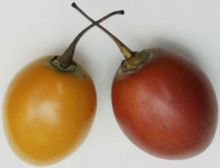Solanum betaceum
| Solanum betaceum subsp. var. | Tamarillo, Tree tomato | |||||||||||||||||||||||||||||||||||||||||||||||||||||||
|---|---|---|---|---|---|---|---|---|---|---|---|---|---|---|---|---|---|---|---|---|---|---|---|---|---|---|---|---|---|---|---|---|---|---|---|---|---|---|---|---|---|---|---|---|---|---|---|---|---|---|---|---|---|---|---|---|

|
|
| ||||||||||||||||||||||||||||||||||||||||||||||||||||||
| ||||||||||||||||||||||||||||||||||||||||||||||||||||||||
Solanum betaceum (syn. Cyphomandra betacea) is a small tree or shrub in the flowering plant family Solanaceae. It is best known as the species that bears the tamarillo, an egg-shaped edible fruit. Other names include tree tomato and tomate de árbol.
The fruit can be between 2 and 8 centimeters in length. They are held on the tree in clusters as are many other clustered fruit, such as cherries. The trees are grown from cuttings and are very frost-tender when young. They are shallow-rooted and respond to deep mulching and abundant water. The tree can grow to a little more than 6 meters but it is subject to wind damage and needs shelter. It will bear fruit after two years and a single mature tree in good soil will carry more fruit than a normal family can eat for about 3 months. A well-nourished tree can produce up to 66 kilograms of fruit in a year. When the tree is about 1 to 1.5 meters in height it is advisable to cut the roots on one side and lean the tree to the other (direction of the midday sun at about 30 to 45 degrees). This allows fruiting branches to grow from all along the trunk rather than just at the top.
The tamarillo is native to the Andes.
Cultivation
Propagation
Pests and diseases
Varieties
Gallery
-
photo 1
-
photo 2
-
photo 3
References
External links
- w:Solanum betaceum. Some of the material on this page may be from Wikipedia, under the Creative Commons license.
- Solanum betaceum QR Code (Size 50, 100, 200, 500)


